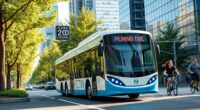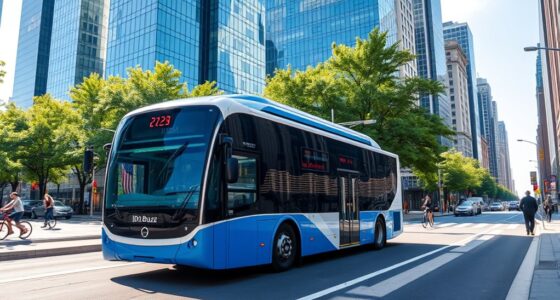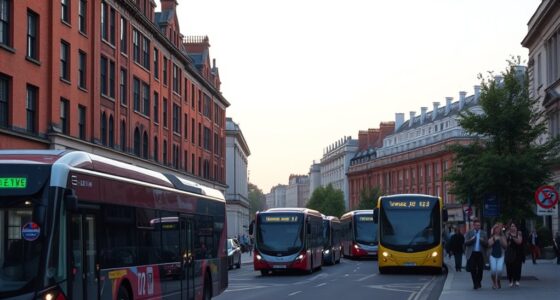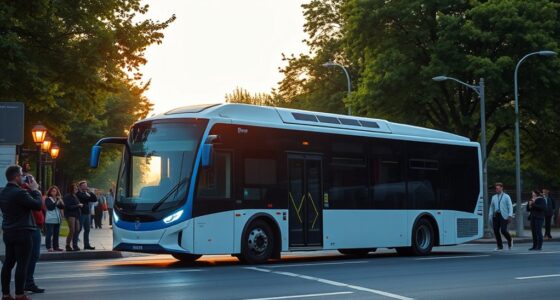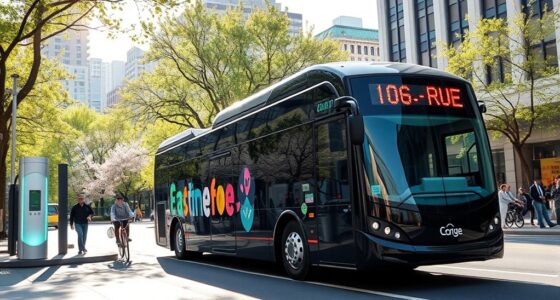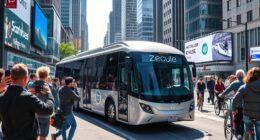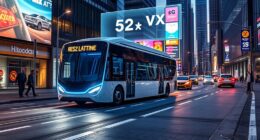Electric buses improve your community’s health by reducing pollution and noise, creating cleaner, quieter urban spaces. They promote fairness by prioritizing underserved populations most impacted by pollution, supporting environmental justice. These buses also boost local economies through job creation and infrastructure development. Community involvement guarantees the shift meets local needs. While infrastructure challenges exist, ongoing efforts make sustainable transportation more accessible. To discover how these changes shape communities and foster lasting benefits, keep exploring the full picture.
Key Takeaways
- Electric buses reduce pollution exposure, improving respiratory health especially in disadvantaged communities facing higher pollution burdens.
- Transitioning to electric buses promotes environmental justice by prioritizing communities most impacted by air and noise pollution.
- Community engagement ensures transit solutions meet local needs, fostering trust and inclusive participation in the transition process.
- Electric buses create economic opportunities through job growth in manufacturing, infrastructure development, and workforce training.
- Reduced noise and cleaner air enhance urban quality of life, benefiting community well-being and public health.
Improving Public Health Through Cleaner Transportation
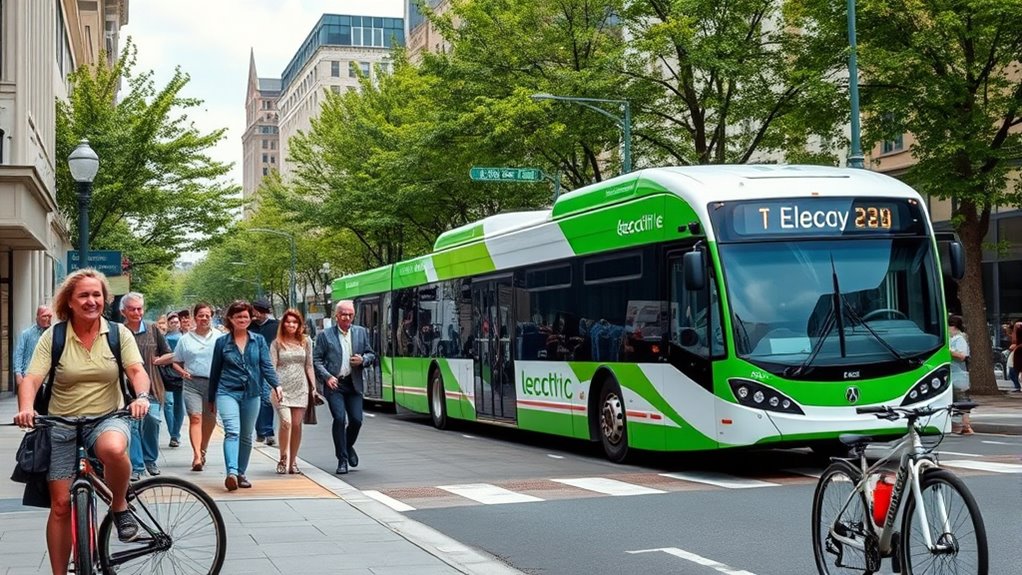
Electric buses play a crucial role in improving public health by providing cleaner transportation options. They eliminate diesel exhaust emissions, which reduces particulate pollution and ground-level ozone formation, leading to better air quality.
Electric buses improve air quality by eliminating diesel exhaust emissions and reducing ground-level ozone formation.
As a result, respiratory health improves, and the risk of respiratory diseases drops for both children and adults. Communities see long-term health savings—an electric bus can save around $55,000 annually in health costs, totaling about $660,000 over its lifespan. Reducing harmful emissions is essential for creating healthier urban environments and supports broader efforts to combat climate change. Implementing sustainable transportation strategies further amplifies these health benefits.
In urban areas where pollution is higher, these benefits are even more significant. By reducing harmful emissions, electric buses lower the incidence of asthma and other respiratory issues, decreasing mortality rates linked to air pollution. Additionally, high refresh rates in electric bus technology ensure smoother operation and reliability, further supporting community health initiatives. Incorporating appropriate maintenance practices helps sustain these benefits over time and enhances the longevity of electric buses.
This cleaner transportation directly benefits community health, creating healthier, safer environments for everyone.
Promoting Environmental Justice and Equity
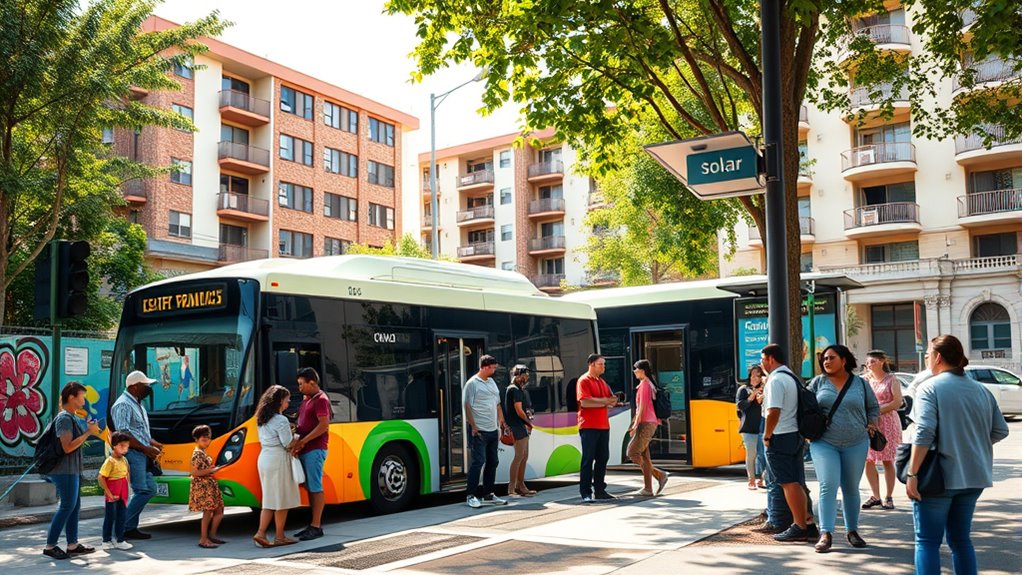
As communities experience the health benefits of cleaner transportation, it’s important to recognize how electric buses can also promote environmental justice and equity. The Electric School Bus Initiative prioritizes communities most impacted by pollution, guaranteeing they benefit first.
Disproportionate impacts on communities of color and underserved populations highlight why electric buses are essential for environmental justice. School bus depots contribute to neighborhood pollution, affecting residents and workers nearby.
Funding partnerships with environmental justice groups help guarantee equitable access, supporting decarbonization goals. Engaging communities directly and involving diverse stakeholders guarantees that transitions meet local needs.
Developing frameworks for accountability and proactively addressing historical disparities are fundamental steps toward equitable distribution. Electric buses therefore serve as a powerful tool to promote fairness and reduce pollution in marginalized communities. Dog names can serve as a reminder of the importance of community identity and cultural heritage in fostering equitable development.
Creating Economic Opportunities in Local Communities
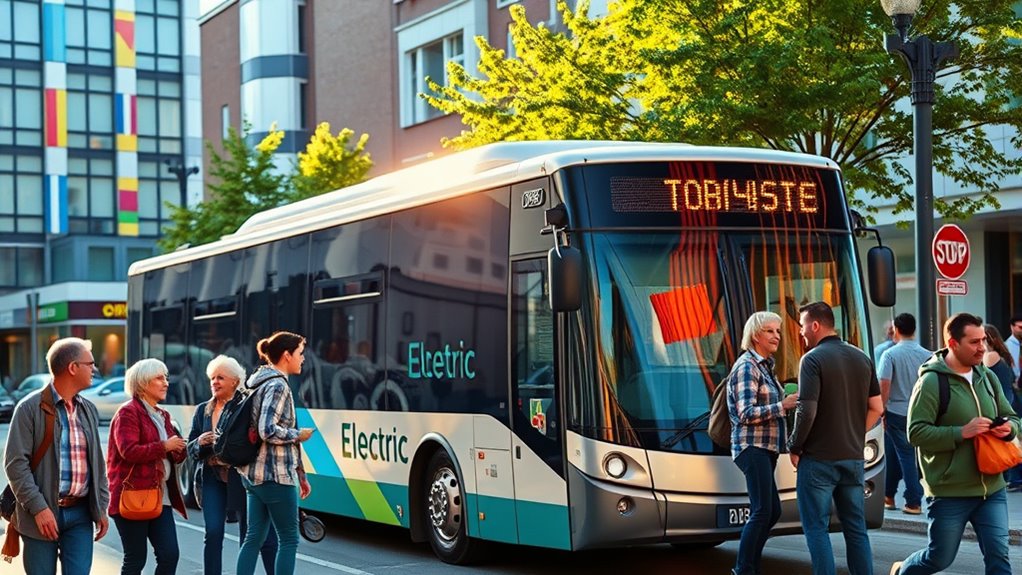
Creating economic opportunities in local communities is a key benefit of shifting to electric buses. When you embrace electric bus manufacturing, you open doors to new jobs in the green vehicle sector, boosting local economies. Companies like Blue Bird Corp. invest in community-based production, creating hundreds of jobs and supporting sustainable growth. Training programs for electric vehicle maintenance increase workforce skills and employability across urban and rural areas. Installing charging infrastructure attracts travelers, benefits local businesses, and encourages longer visits. These investments not only stimulate regional economic development but also foster innovation in green industries. Additionally, implementing advanced fraud detection techniques helps protect transactions and ensures the integrity of funding for community projects. Furthermore, the adoption of electric buses can promote environmental benefits that enhance the community’s quality of life. Plus, the lower operational costs of electric buses lead to long-term savings for school districts, freeing up resources to support local businesses and community projects. Incorporating sustainable practices, such as using renewable energy sources for charging, can further amplify these positive impacts.
Engaging Communities in the Transition Process
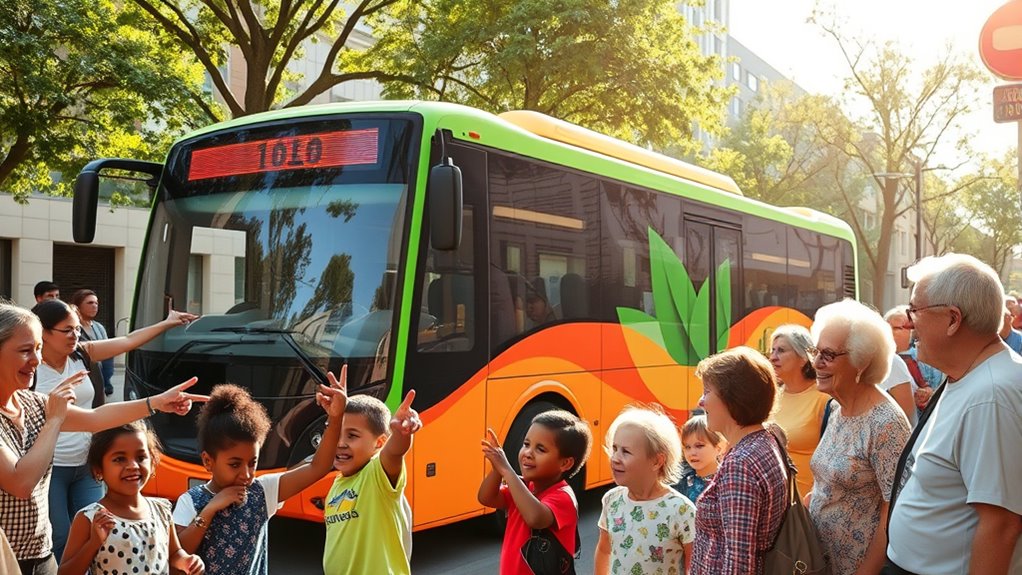
Engaging communities in the change to electric buses is essential for guaranteeing that the shift is equitable and responsive to local needs. Your involvement helps identify priority routes and areas, making sure the transition benefits those most affected by pollution.
Community engagement ensures an equitable, responsive transition to electric buses that benefits those most impacted by pollution.
By including local voices in decision-making, you can build trust, prevent unintended issues, and foster community support. Educating residents about electric buses’ health and environmental benefits through events and campaigns encourages participation. Additionally, providing community education about the technology and benefits of electric buses can dispel misconceptions and foster support.
Research indicates that comprehensive community participation enhances the overall success of transportation initiatives by ensuring diverse perspectives are considered. Prioritizing low-income and marginalized communities guarantees equitable access. Training local workers creates jobs and strengthens community capacity. Additionally, involving community members also supports the development of AI security strategies that protect sensitive data and enhance safety during the transition.
Incorporating community engagement strategies into planning processes leads to more sustainable and accepted transportation solutions, fostering long-term positive impacts.
Addressing Infrastructure and Technological Challenges
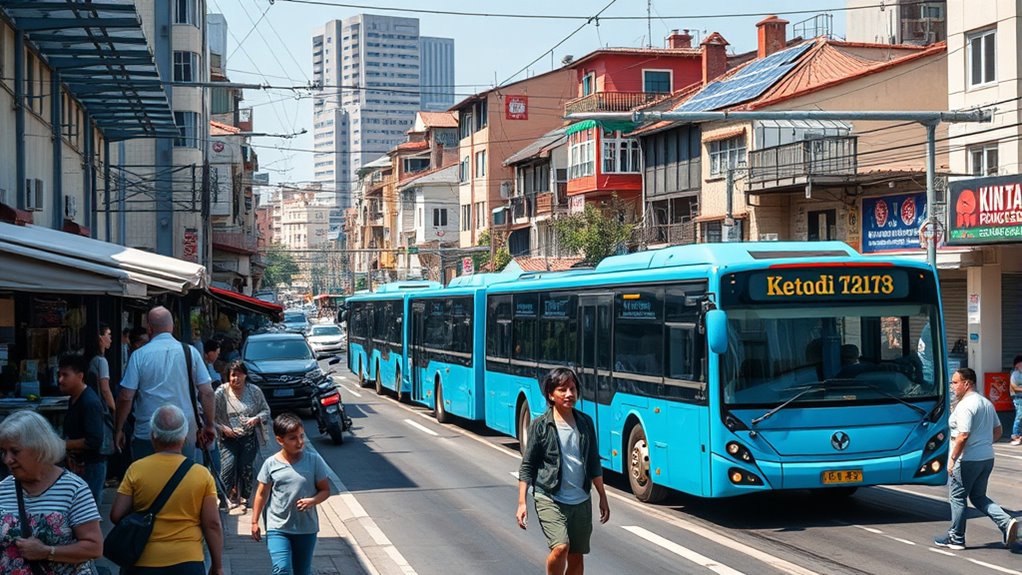
Addressing infrastructure and technological challenges is essential to facilitate a smooth progression to electric buses. You’ll face high upfront costs for vehicles and charging stations, with each station costing around $20,000 to $25,000. Limited space and power capacity in urban areas can complicate setup, requiring careful planning. Battery range variability affects route planning, while integrating new charging infrastructure into existing electrical grids presents utility hurdles. Staff training is necessary for maintenance and operations, adding to the complexity. Managing charging schedules and ensuring fleet size matches available infrastructure are operational priorities. Additionally, high vehicle costs and infrastructure investments strain budgets. Without standardized infrastructure and supportive policies, expanding electric bus fleets becomes more difficult, delaying the benefits for communities and increasing long-term costs. One significant challenge is the lack of uniform charging standards, which can hinder interoperability and scalability across different systems and regions. Developing clear charging protocols can help streamline deployment and promote wider adoption. Furthermore, establishing standardized infrastructure can facilitate easier integration and reduce costs associated with incompatible systems. Emphasizing the importance of collaborative efforts among stakeholders can also accelerate the development of effective solutions and shared best practices.
Reducing Noise and Air Pollution for Community Well-being
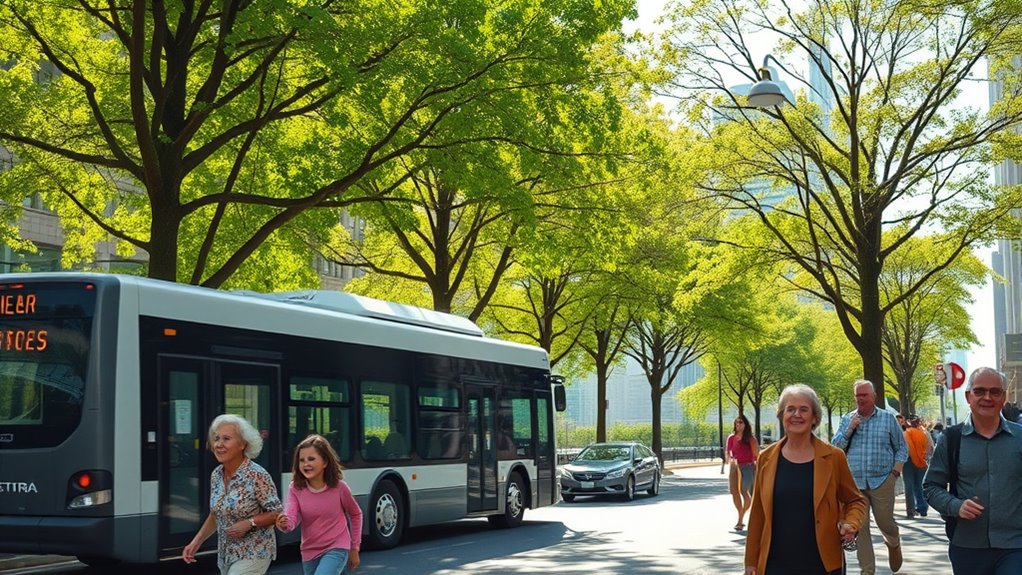
As communities work to expand electric bus fleets, the benefits extend beyond infrastructure to include substantial improvements in noise and air quality. Electric buses are much quieter than diesel models, producing almost no engine noise or vibrations, which creates a calmer, more enjoyable environment.
This reduction in noise pollution lowers stress and sleep disturbances for residents. Additionally, electric buses produce zero emissions, markedly improving air quality by eliminating harmful particulates and nitrogen oxides. Implementing electric buses also supports sustainable transportation initiatives, which contribute to long-term environmental benefits. Moreover, the adoption of electric buses can inspire broader community engagement in environmental conservation efforts, fostering a culture of sustainability.
Furthermore, transitioning to electric buses can help communities meet regulatory standards for emissions and noise, ensuring compliance with environmental policies. Advanced electric vehicle technology is rapidly evolving, making these buses more efficient and cost-effective than ever before. Cleaner air helps reduce respiratory issues and promotes better public health. Overall, these changes foster healthier, more sustainable urban spaces, making neighborhoods more livable.
The quieter, cleaner environment benefits everyone, supporting community well-being and enhancing the quality of urban life.
Supporting Vulnerable Populations With Inclusive Policies

Supporting vulnerable populations with inclusive policies guarantees that the benefits of electric buses reach everyone, especially those in underserved communities. By reducing exposure to harmful pollutants, electric buses lower health risks like asthma and lung cancer, improving air quality where it’s needed most.
Inclusive policies ensure all communities benefit from electric buses and improved air quality.
Cleaner air supports better cognitive and academic outcomes for children in marginalized areas. Policies that develop charging infrastructure and provide affordable transportation ensure low-income households can access electric bus services. Implementing equitable route planning and community engagement strategies can address transportation disparities effectively. Additionally, understanding the horsepower of electric dirt bikes can inform discussions on vehicle performance and energy efficiency, emphasizing the importance of sustainable transportation options.
The integration of public transportation policies that prioritize vulnerable communities can foster social inclusion and economic mobility. These efforts promote health equity, reduce disparities, and help vulnerable populations enjoy the full advantages of electric bus transitions.
Ensuring Long-term Sustainability and Equitable Access
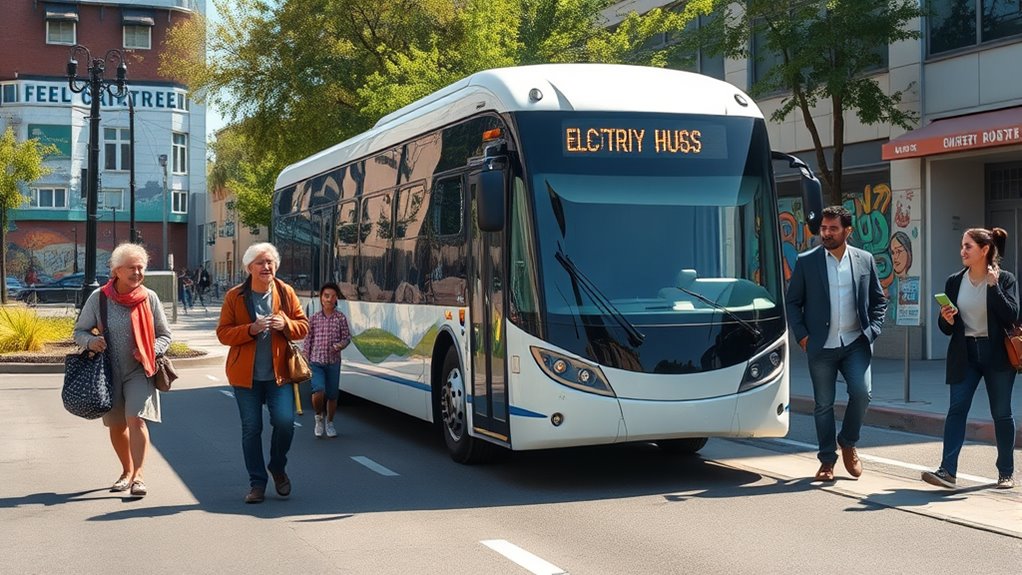
Ensuring long-term sustainability and equitable access to electric buses requires strategic planning and investment. You’ll benefit from lower operational costs, as electric buses use about half as much to run, thanks to cheaper energy and reduced maintenance needs.
They produce no tailpipe emissions, helping improve air quality and fight climate change, especially when powered by renewable energy. To guarantee fair access, communities can leverage government incentives, making electric buses more affordable and encouraging public transit use.
Addressing infrastructure needs, like accessible charging stations, is essential for reliable operation. Engaging communities through education and transparent policies builds trust and support.
Frequently Asked Questions
How Do Electric Buses Impact Local Property Values and Community Development?
Electric buses positively impact local property values and community development by improving air quality and reducing noise, making neighborhoods more attractive. You’ll notice higher property values as residents enjoy a healthier, quieter environment.
Additionally, communities often see increased investment in green infrastructure, which can attract new businesses and residents. These changes boost overall development, fostering a more sustainable and appealing community for everyone.
What Measures Are Taken to Prevent Displacement of Marginalized Residents During Electrification?
Imagine a city installing electric buses in a low-income neighborhood. To prevent displacement, policymakers prioritize equitable funding to upgrade infrastructure and involve residents in planning.
They also implement policies to protect affordable housing and guarantee community benefits. These measures help avoid gentrification, allowing residents to enjoy cleaner air and better transit without losing their homes or community identity during the shift to electrification.
How Do Electric Buses Affect the Overall Cost of Public Transit Services?
You’ll notice that electric buses initially cost more than diesel models, mainly due to higher purchase and infrastructure expenses. However, over time, you save markedly on fuel and maintenance, which can offset the upfront costs.
Plus, incentives and innovative revenue streams, like Vehicle-to-Grid, help improve financial sustainability.
Ultimately, electrification can lower the overall cost of public transit services, especially as technology advances and costs decrease.
What Are the Long-Term Maintenance and Operational Challenges for Electric Bus Fleets?
You’ll face long-term maintenance and operational challenges with electric bus fleets, like managing complex electronic systems and monitoring battery health.
Charging infrastructure must stay reliable, and scheduling needs to optimize charging times without disrupting service.
You’ll also need staff trained in new technologies, and you’ll have to adapt to fluctuating energy costs.
Planning for scalable infrastructure and routine diagnostics is essential to keep operations smooth and cost-effective over time.
How Can Communities Ensure Equitable Access to Charging Infrastructure Across Neighborhoods?
Imagine neighborhoods as vibrant tapestries, each with unique needs. You can guarantee equitable access by prioritizing low-income areas for charging sites, using census data to identify vulnerable communities, and involving residents early on.
Focus on transit hubs and schools, integrate renewable energy, and keep transparency through metrics.
Partner with local organizations, and provide subsidized rates. Your actions help bridge disparities, making clean transportation accessible for all, weaving equity into every corner of the community.
Conclusion
By adopting electric buses, you can dramatically improve community health—reducing air pollution by up to 80%. This shift also promotes environmental justice, creates local jobs, and supports vulnerable populations. Your involvement helps guarantee a cleaner, quieter, and more equitable future. Embrace the transition, knowing it’s not just about cleaner air, but about building resilient communities that benefit everyone. Together, you can drive meaningful change for a healthier tomorrow.

